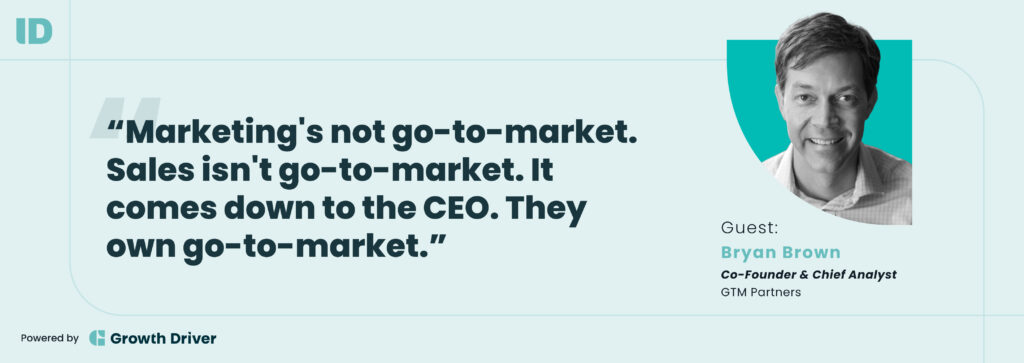A robust go-to-market (GTM) strategy isn’t just a luxury—it’s a necessity. But what makes a GTM motion truly effective? Who should own your go-to-market? These questions are more pressing than ever as B2B leaders seek to drive efficient growth.
In this blog post, we’ll unravel the complexities of creating a successful GTM motion, highlight the importance of cross-functional alignment, and discuss who should take the reins in steering your GTM initiatives. For deeper insights and real-world examples, tune into our conversation with Bryan Brown, Co-Founder & Chief Analyst of GTM Partners, on ID’s podcast Growth Driver.
The Importance of Cross-Functional Alignment in GTM
When it comes to GTM motions, having everyone on the same page is not just beneficial—it’s vital. Cross-functional alignment ensures that your teams work together seamlessly, from strategy formulation to execution. Without it, even the most brilliant strategies can crumble.
Breaking Down Silos for Unified Success
Silos within organizations are a common barrier to GTM success. When departments like marketing, sales, and customer service operate in isolation, it can lead to miscommunication, misplaced priorities, and ultimately, a fractured customer experience. For a GTM motion to be truly effective, these silos must be broken down to ensure your entire GTM team is aligned–from strategy, to execution, all the way through to reporting.

The CEO as the Go-To-Market Champion
One of the most critical aspects of a successful GTM motion is establishing who owns it. While many might assume it falls solely under the marketing umbrella, this task requires a higher level of oversight and vision.
Why the CEO Should Lead GTM Efforts
The CEO needs to be the champion of your chosen GTM motion. They can bridge the gap between departments, ensuring that everyone is aligned with the company’s vision and objectives. This leadership is essential for maintaining focus and driving the GTM strategy forward.
Listening to the Experts
For those keen on mastering GTM motions, insights from industry experts like Bryan Brown can provide invaluable guidance. His experience in defining and executing GTM strategies offers practical advice and innovative approaches.
Highlights from Our Conversation with Bryan Brown
In our discussion with Bryan Brown, he emphasized the importance of viewing GTM as a living, breathing part of the organization. He shared insights on how to adapt GTM strategies to changing market conditions and the role of data in informing decisions.
B2B leaders can learn from Bryan’s emphasis on adaptability and data-driven decision-making. By remaining flexible and open to new information, organizations can refine their GTM strategies to remain competitive in an ever-evolving marketplace.
Crafting a Winning GTM Strategy
Creating a successful GTM strategy requires a blend of art and science. It involves understanding your market, aligning your teams, and continuously adapting to remain relevant and effective.
Every GTM strategy will face challenges. Whether it’s internal resistance, changing market dynamics, or resource constraints, being prepared with contingency plans and maintaining a flexible mindset can help overcome these hurdles. With your CEO as the GTM Champion, you’ll be well equipped to face whatever challenges come your way head on.




